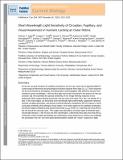| dc.contributor.author | Zaidi, Farhan H. | |
| dc.contributor.author | Peirson, Stuart N. | |
| dc.contributor.author | Wulff, Katharina | |
| dc.contributor.author | Brainard, George C. | |
| dc.contributor.author | Gregory-Evans, Kevin | |
| dc.contributor.author | Moseley, Merrick J. | |
| dc.contributor.author | Hull, Joseph Thomas | |
| dc.contributor.author | Aeschback, Daniel | |
| dc.contributor.author | Gooley, Joshua James | |
| dc.contributor.author | Rizzo, Joseph F. | |
| dc.contributor.author | Czeisler, Charles Andrew | |
| dc.contributor.author | Foster, Russell G. | |
| dc.contributor.author | Lockley, Steven Ward | |
| dc.date.accessioned | 2011-04-18T03:59:37Z | |
| dc.date.issued | 2007 | |
| dc.identifier.citation | Zaidi, Farhan H., Joseph T. Hull, Stuart N. Peirson, Katharina Wulff, Daniel Aeschbach, Joshua J. Gooley, George C. Brainard, et al. 2007. Short-wavelength light sensitivity of circadian, pupillary, and visual awareness in humans lacking an outer retina. Current Biology 17(24): 2122-2128. | en_US |
| dc.identifier.issn | 0960-9822 | en_US |
| dc.identifier.uri | http://nrs.harvard.edu/urn-3:HUL.InstRepos:4853416 | |
| dc.description.abstract | Summary As the ear has dual functions for audition and balance, the eye has a dual role in detecting light for a wide range of behavioral and physiological functions separate from sight [1–11]. These responses are driven primarily by stimulation of photosensitive retinal ganglion cells (pRGCs) that are most sensitive to short-wavelength (∼480 nm) blue light and remain functional in the absence of rods and cones [8–10]. We examined the spectral sensitivity of non-image-forming responses in two profoundly blind subjects lacking functional rods and cones (one male, 56 yr old; one female, 87 yr old). In the male subject, we found that short-wavelength light preferentially suppressed melatonin, reset the circadian pacemaker, and directly enhanced alertness compared to 555 nm exposure, which is the peak sensitivity of the photopic visual system. In an action spectrum for pupillary constriction, the female subject exhibited a peak spectral sensitivity (λmax) of 480 nm, matching that of the pRGCs but not that of the rods and cones. This subject was also able to correctly report a threshold short-wavelength stimulus (∼480 nm) but not other wavelengths. Collectively these data show that pRGCs contribute to both circadian physiology and rudimentary visual awareness in humans and challenge the assumption that rod- and cone-based photoreception mediate all “visual” responses to light. | en_US |
| dc.language.iso | en_US | en_US |
| dc.publisher | Cell Press | en_US |
| dc.relation.isversionof | doi:10.1016/j.cub.2007.11.034 | en_US |
| dc.relation.hasversion | http://www.ncbi.nlm.nih.gov/pmc/articles/PMC2151130/pdf/ | en_US |
| dash.license | LAA | |
| dc.title | Short-Wavelength Light Sensitivity of Circadian, Pupillary, and Visual Awareness in Humans Lacking an Outer Retina | en_US |
| dc.type | Journal Article | en_US |
| dc.description.version | Version of Record | en_US |
| dc.relation.journal | Current Biology | en_US |
| dash.depositing.author | Hull, Joseph Thomas | |
| dc.date.available | 2011-04-18T03:59:37Z | |
| dash.affiliation.other | HMS^Medicine-Brigham and Women's Hospital | en_US |
| dash.affiliation.other | HMS^Medicine-Brigham and Women's Hospital | en_US |
| dash.affiliation.other | HMS^Medicine-Brigham and Women's Hospital | en_US |
| dash.affiliation.other | HMS^Medicine-Brigham and Women's Hospital | en_US |
| dc.identifier.doi | 10.1016/j.cub.2007.11.034 | * |
| dash.authorsordered | false | |
| dash.contributor.affiliated | Hull, Joseph Thomas | |
| dash.contributor.affiliated | Gooley, Joshua James | |
| dash.contributor.affiliated | Rizzo, Joseph | |
| dash.contributor.affiliated | Lockley, Steven | |
| dash.contributor.affiliated | Czeisler, Charles | |


